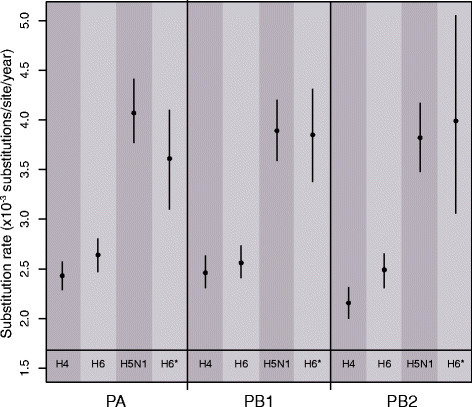Avian influenza virus exhibits distinct evolutionary dynamics in wild birds and poultry
- PMID: 26111936
- PMCID: PMC4481119
- DOI: 10.1186/s12862-015-0410-5
Avian influenza virus exhibits distinct evolutionary dynamics in wild birds and poultry
Abstract
Background: Wild birds are the major reservoir hosts for influenza A viruses, occasionally transmitting to other species such as domesticated poultry. Despite an abundance of genomic data from avian influenza virus (AIV), little is known about whether AIV evolves differently in wild birds and poultry, although this is critical to revealing the dynamics and time-scale of viral evolution. In particular, because environmental (water-borne) transmission is more common in wild birds, which may reduce the number of replications per unit time, it is possible that evolutionary rates are systematically lower in wild birds than in poultry.
Results: We estimated rates of nucleotide substitution in two AIV subtypes that are strongly associated with infections in wild birds - H4 and H6 - and compared these to rates in the H5N1 subtype that has circulated in poultry for almost two decades. Our analyses of three internal genes confirm that H4 and H6 viruses are evolving significantly more slowly than H5N1 viruses, suggesting that evolutionary rates of AIV are reduced in wild birds. This result was verified by the analysis of a poultry-associated H6 lineage that exhibited a markedly higher substitution rate than those H6 viruses circulating in wild birds. Interestingly, we also observed a significant difference in evolutionary rate between H4 and H6, despite frequent reassortment rate among them.
Conclusions: AIV experiences markedly different evolutionary dynamics between wild birds and poultry. These results suggest that rate heterogeneity among viral subtypes and ecological groupings should be taken into account when estimating evolutionary rates and divergence times.
Figures

Similar articles
-
Surveillance of avian influenza viruses in South Korea between 2012 and 2014.Virol J. 2017 Mar 14;14(1):54. doi: 10.1186/s12985-017-0711-y. Virol J. 2017. PMID: 28292308 Free PMC article.
-
Avian influenza A viruses in birds --an ecological, ornithological and virological view.Dtsch Tierarztl Wochenschr. 2005 Dec;112(12):448-56. Dtsch Tierarztl Wochenschr. 2005. PMID: 16425630 Review.
-
Evolutionary dynamics and emergence of panzootic H5N1 influenza viruses.PLoS Pathog. 2008 Sep 26;4(9):e1000161. doi: 10.1371/journal.ppat.1000161. PLoS Pathog. 2008. PMID: 18818732 Free PMC article.
-
Evolutionary trajectories and diagnostic challenges of potentially zoonotic avian influenza viruses H5N1 and H9N2 co-circulating in Egypt.Infect Genet Evol. 2015 Aug;34:278-91. doi: 10.1016/j.meegid.2015.06.004. Epub 2015 Jun 3. Infect Genet Evol. 2015. PMID: 26049044
-
Evolution and Reassortment of H6 Subtype Avian Influenza Viruses.Viruses. 2023 Jul 13;15(7):1547. doi: 10.3390/v15071547. Viruses. 2023. PMID: 37515233 Free PMC article. Review.
Cited by
-
Low Pathogenicity H7N3 Avian Influenza Viruses Have Higher Within-Host Genetic Diversity Than a Closely Related High Pathogenicity H7N3 Virus in Infected Turkeys and Chickens.Viruses. 2022 Mar 8;14(3):554. doi: 10.3390/v14030554. Viruses. 2022. PMID: 35336961 Free PMC article.
-
Zoonotic Potential of Influenza A Viruses: A Comprehensive Overview.Viruses. 2018 Sep 13;10(9):497. doi: 10.3390/v10090497. Viruses. 2018. PMID: 30217093 Free PMC article. Review.
-
A Turkey-origin H9N2 Avian Influenza Virus Shows Low Pathogenicity but Different Within-Host Diversity in Experimentally Infected Turkeys, Quail and Ducks.Viruses. 2020 Mar 16;12(3):319. doi: 10.3390/v12030319. Viruses. 2020. PMID: 32188100 Free PMC article.
-
The impact of migratory flyways on the spread of avian influenza virus in North America.BMC Evol Biol. 2017 May 25;17(1):118. doi: 10.1186/s12862-017-0965-4. BMC Evol Biol. 2017. PMID: 28545432 Free PMC article.
-
Association of poultry vaccination with interspecies transmission and molecular evolution of H5 subtype avian influenza virus.Sci Adv. 2025 Jan 24;11(4):eado9140. doi: 10.1126/sciadv.ado9140. Epub 2025 Jan 22. Sci Adv. 2025. PMID: 39841843 Free PMC article.
References
MeSH terms
LinkOut - more resources
Full Text Sources
Other Literature Sources
Medical

